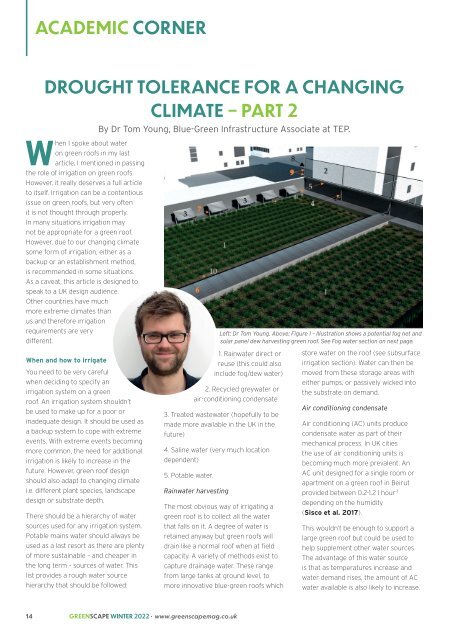Winter 2022
You also want an ePaper? Increase the reach of your titles
YUMPU automatically turns print PDFs into web optimized ePapers that Google loves.
ACADEMIC CORNER<br />
DROUGHT TOLERANCE FOR A CHANGING<br />
CLIMATE – PART 2<br />
By Dr Tom Young, Blue-Green Infrastructure Associate at TEP.<br />
When I spoke about water<br />
on green roofs in my last<br />
article, I mentioned in passing<br />
the role of irrigation on green roofs.<br />
However, it really deserves a full article<br />
to itself. Irrigation can be a contentious<br />
issue on green roofs, but very often<br />
it is not thought through properly.<br />
In many situations irrigation may<br />
not be appropriate for a green roof.<br />
However, due to our changing climate<br />
some form of irrigation, either as a<br />
backup or an establishment method,<br />
is recommended in some situations.<br />
As a caveat, this article is designed to<br />
speak to a UK design audience.<br />
Other countries have much<br />
more extreme climates than<br />
us and therefore irrigation<br />
requirements are very<br />
different.<br />
When and how to irrigate<br />
You need to be very careful<br />
when deciding to specify an<br />
irrigation system on a green<br />
roof. An irrigation system shouldn’t<br />
be used to make up for a poor or<br />
inadequate design. It should be used as<br />
a backup system to cope with extreme<br />
events. With extreme events becoming<br />
more common, the need for additional<br />
irrigation is likely to increase in the<br />
future. However, green roof design<br />
should also adapt to changing climate<br />
i.e. different plant species, landscape<br />
design or substrate depth.<br />
There should be a hierarchy of water<br />
sources used for any irrigation system.<br />
Potable mains water should always be<br />
used as a last resort as there are plenty<br />
of more sustainable – and cheaper in<br />
the long term – sources of water. This<br />
list provides a rough water source<br />
hierarchy that should be followed:<br />
Left: Dr Tom Young. Above: Figure 1 – Illustration shows a potential fog net and<br />
solar panel dew harvesting green roof. See Fog water section on next page.<br />
1. Rainwater direct or<br />
reuse (this could also<br />
include fog/dew water)<br />
2. Recycled greywater or<br />
air-conditioning condensate<br />
3. Treated wastewater (hopefully to be<br />
made more available in the UK in the<br />
future)<br />
4. Saline water (very much location<br />
dependent)<br />
5. Potable water.<br />
Rainwater harvesting<br />
The most obvious way of irrigating a<br />
green roof is to collect all the water<br />
that falls on it. A degree of water is<br />
retained anyway but green roofs will<br />
drain like a normal roof when at field<br />
capacity. A variety of methods exist to<br />
capture drainage water. These range<br />
from large tanks at ground level, to<br />
more innovative blue-green roofs which<br />
store water on the roof (see subsurface<br />
irrigation section). Water can then be<br />
moved from these storage areas with<br />
either pumps, or passively wicked into<br />
the substrate on demand.<br />
Air conditioning condensate<br />
Air conditioning (AC) units produce<br />
condensate water as part of their<br />
mechanical process. In UK cities<br />
the use of air conditioning units is<br />
becoming much more prevalent. An<br />
AC unit designed for a single room or<br />
apartment on a green roof in Beirut<br />
provided between 0.2-1.2 l hour -1<br />
depending on the humidity<br />
(Sisco et al. 2017).<br />
This wouldn’t be enough to support a<br />
large green roof but could be used to<br />
help supplement other water sources.<br />
The advantage of this water source<br />
is that as temperatures increase and<br />
water demand rises, the amount of AC<br />
water available is also likely to increase.<br />
14 GREENSCAPE WINTER <strong>2022</strong> • www.greenscapemag.co.uk

















